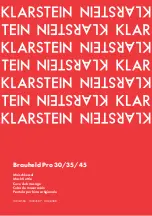
10
| EN
RIS 400-700 P EKO 3.0 v2019.06
* Component/posibility to connect it depends on model. For more information please, check the manual
16. CONNECTION OF THE UNIT TO ELECTRIC NETWORK
• Supply voltage to the unit must be connected by a qualified specialist following the manufacturer’s instructions and effective safety instructions.
• The unit’s power network voltage must correspond to electrotechnical parameters of the unit indicated in the technical decal.
• The unit’s voltage, power and other technical parameters are provided in the unit’s technical decal (on the unit casing). The unit must be connect-
ed to the voltage plug socket of the grounded power network in compliance with the effective requirements.
• The unit must be earthed according to the rules on installing electrical equipment.
• It is prohibited to use extension wires (cables) and power network plug socket distribution devices.
• Prior to carrying out any ventilation unit installation and connection activities (until its hand-over to the customer), the unit must be disconnected
from the power network.
• After installation of the ventilation unit, the power network plug socket must be accessible at any time and disconnection from the power network
is performed through the two-pole circuit breaker (by disconnecting phase pole and neutral).
• The unit must be thoroughly checked against damages (execution, control, measurement nodes) during transportation before it is connected to
the power network.
• The power cable can be replaced only by a qualified specialist upon the evaluation of the rated power and current.
The manufacturer does not assume any liability for personal injuries and property damage due to nonconformance with the
provided instructions.
17. START-UP RECOMMENDATIONS
17.1. RECOMMENDATIONS BEFORE THE START OF THE UNIT (BEFORE THE FINAL USER)
Prior to start-up the system must be thoroughly cleaned. Check whether:
• operation systems and unit elements as well as automation and automation devices were not damaged during installation,
• all electrical devices are connected to power supply and fit for service,
• all necessary automation elements are installed and connected to power supply and terminal blocks,
• cable connection to terminal blocks comply with the existing power connection diagrams,
• all electrical equipment protection elements are properly connected (if they are additionally used),
• cables and wires correspond to all applicable safety and functional requirements, diameters, etc.,
• earthing and protection systems are properly installed,
• condition of all seals and sealing surfaces are proper.
17.2. POSSIBLE FAULTS AND TROUBLESHOOTING
FAILURE
CAUSE
EXPLANATION / CORRECTIVE ACTIONS
Unit is not operating
No supply voltage
Check whether the device is connected to the
power network
Protection device is off or a current
leakage relay is active (if installed by the
installer)
Switch on only if the unit condition has been
evaluated by a qualified electrician. If the sys
-
tem failed, the failure MUST BE rectified prior
to switching it on.
Air supply heater or pre-heater is not operat-
ing or malfunctioning (if installed)
Too low air flow in air ducts activates auto
-
matic
protection
Check if air filters are not clogged
Check if fans are rotating
Manual protection is activated
Possible heater or unit failure. MUST contact
the servicing staff for failure detection and its
elimination.
Too low air flow at rated fan speed
Clogged supply and/or extract air filter(s)
Filter replacement needed
Filters are clogged and no message is shown
on the remote control
Wrong time in filter timers or their switch is
broken, or its pressure is set improperly.
Shorten filter timer time till the message of
clogged filters or replace the pressure switch
of the filters, or set their proper pressure.
18. MAINTENANCE
Before opening the covers:
1. Unplug unit from mains first and wait for 2 minutes (till fans fully stop).
2. Remove draining pipe.
18.1. FILTERS
Dirty filters increase air resistance in the filter, i.e. less air volume is supplied into the premises.
- Filter preferably should be exchanged with a new one every 3 months or when the filter clogging sensor indicates. (sensor available as acces
-
sory).











































